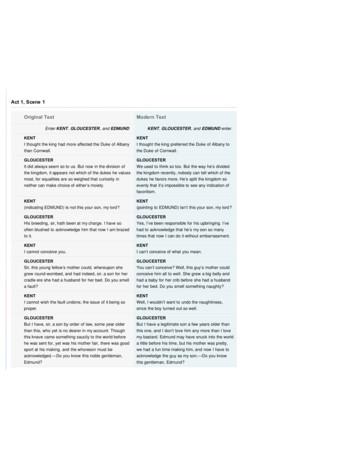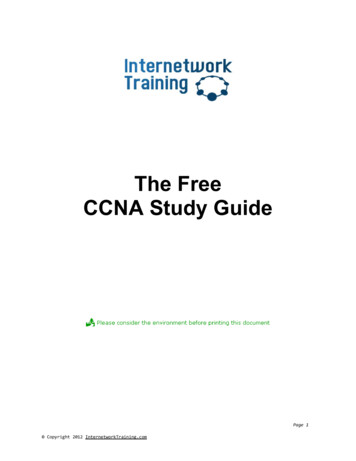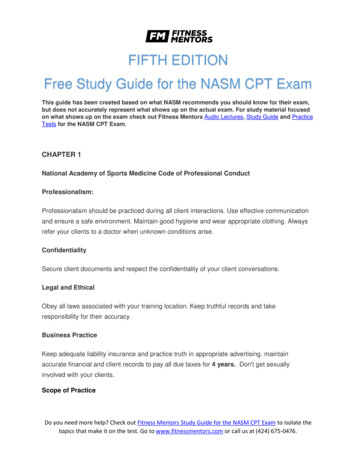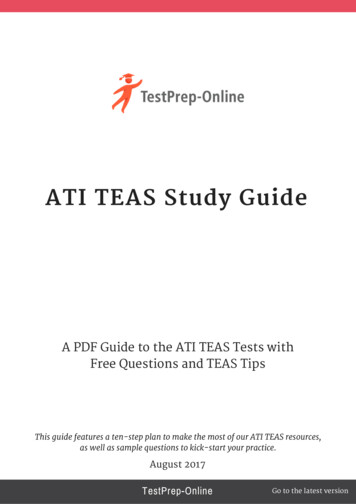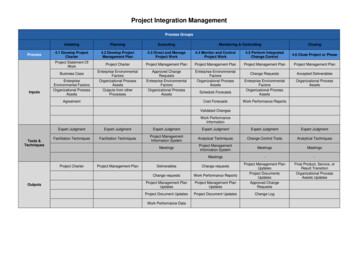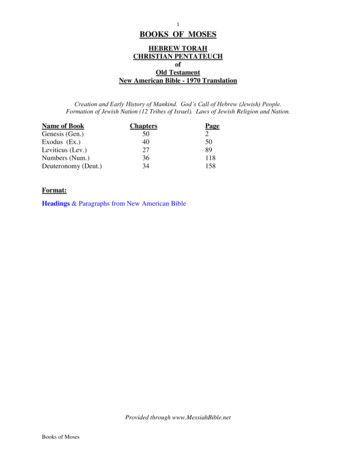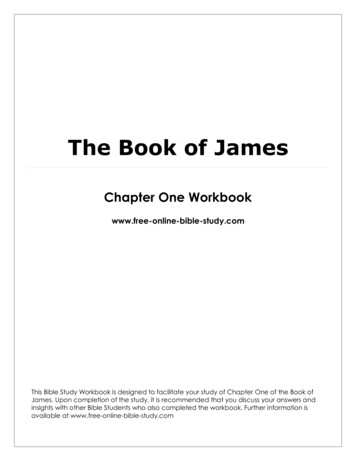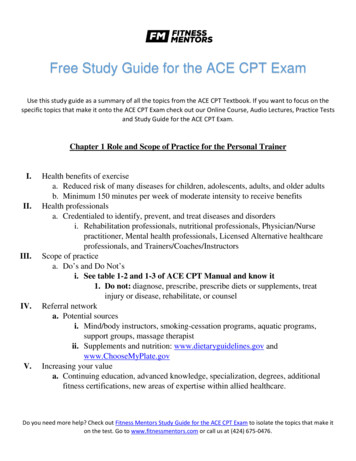
Transcription
Free Study Guide for the ACE CPT ExamUse this study guide as a summary of all the topics from the ACE CPT Textbook. If you want to focus on thespecific topics that make it onto the ACE CPT Exam check out our Online Course, Audio Lectures, Practice Testsand Study Guide for the ACE CPT Exam.Chapter 1 Role and Scope of Practice for the Personal TrainerI.II.III.IV.V.Health benefits of exercisea. Reduced risk of many diseases for children, adolescents, adults, and older adultsb. Minimum 150 minutes per week of moderate intensity to receive benefitsHealth professionalsa. Credentialed to identify, prevent, and treat diseases and disordersi. Rehabilitation professionals, nutritional professionals, Physician/Nursepractitioner, Mental health professionals, Licensed Alternative healthcareprofessionals, and Trainers/Coaches/InstructorsScope of practicea. Do’s and Do Not’si. See table 1-2 and 1-3 of ACE CPT Manual and know it1. Do not: diagnose, prescribe, prescribe diets or supplements, treatinjury or disease, rehabilitate, or counselReferral networka. Potential sourcesi. Mind/body instructors, smoking-cessation programs, aquatic programs,support groups, massage therapistii. Supplements and nutrition: www.dietaryguidelines.gov andwww.ChooseMyPlate.govIncreasing your valuea. Continuing education, advanced knowledge, specialization, degrees, additionalfitness certifications, new areas of expertise within allied healthcare.Do you need more help? Check out Fitness Mentors Study Guide for the ACE CPT Exam to isolate the topics that make iton the test. Go to www.fitnessmentors.com or call us at (424) 675-0476.
Chapter 2 Principles of Adherence and MotivationI.II.Motivation (in regards to exercise)a. intrinsic motivation: person truly enjoys exercise and the pleasure/emotions andexperience that comes from engaging in it. Increases adherenceb. extrinsic motivation: participation for any benefit other than enjoyment such asweight loss, trying to be healthy, looking good, meeting new people. Feelings oftension, guilt, or pressure related to their participationc. self-efficacy: belief in one’s own capability to engage in a physical-activityprogramMaintaining Client Motivationa. Social support: a network of family, friends, co-workers, etc who support one’sinvolvement in exercise and acts as a coping strategy for relapse (returning to anunhealthy/inactive state) preventioni. Strategies for building a social support system1. find a workout partner2. ask friends and family to be encouraging, as well as asking them forreminders about goals or appointments3. set up “fun” contests4. add a social element5. find an enjoyable activityii. Fighting negative social influences1. Balance time with unsupportive people and supportive2. Set limits on how much time is spent with unsupportive people3. Mentally prepare4. Mentally review5. Explain to them why exercise is important for youb. Assertivenessi. Honest, straightforward expression of thoughts, feelings, and beliefsc. Self-regulationDo you need more help? Check out Fitness Mentors Study Guide for the ACE CPT Exam to isolate the topics that make iton the test. Go to www.fitnessmentors.com or call us at (424) 675-0476.
III.IV.V.VI.i. Teach clients to take control over their behavior instead of doing it for themd. High-risk situationsi. Teach clients to be prepared for barriers and relapses and have a plan ofaction for when high-risk situations occur. Give them coping strategies andmore educationInfluences on adherence and participationa. Personal attributesi. demographic variables, health status, activity history, psychological traits,knowledge, attitudes, and beliefs1. locus of control – belief in personal control over health outcomesb. Environmental factorsi. Access to facilitiesii. Timeiii. Social supportc. Physical-Activity factorsi. Intensity1. Program too intense causes dropoutii. InjuryFeedbacka. Extrinsic feedback: reinforcement, error correction, and encouragementb. Intrinsic feedback: information that the clients provide themselves based on theirown sensory systems (what they feel, see, or hear)c. Knowledge of results: provides information on progressLeadership Qualities of the Trainera. Professionalismi. Neat, clean, and non-threatening appearance. Being punctual and preparedb. Trust and credibilityc. Demonstrates listening abilitiesd. Demonstrates excitement for their jobe. Continuing to show clients they caref. Takes time to think about clients experiences through the clients’ eyesHow the Trainer can Help Build Adherencea. Program Designb. Role Clarityc. Goal SettingDo you need more help? Check out Fitness Mentors Study Guide for the ACE CPT Exam to isolate the topics that make iton the test. Go to www.fitnessmentors.com or call us at (424) 675-0476.
i. Avoid too many goals and avoid negative goalsii. Set short- and long-term goalsiii. Revisit goals on a regular basisd. Contracts and agreementsChapter 3 Effective Communication and Coaching StrategiesI.Client – Trainer Relationshipsa. Rapport stage: mutual understanding and trust in a relationship both verbal andnonverbali. Continues to build over timeii. Positive first impressionsiii. Verbal and nonverbal1. Voice quality – inspire confidence, don’t sound weak or hesitant2. Eye contact – direct and friendly3. Facial expressions – try to convey genuine emotion4. Hand gestures – too much is distracting, keep hands quiet5. Body position – exhibit good postureb. Investigation stage: review clients’ health and fitness data, any available testresults, medical clearance information, and clients’ goals and exercise historyi. Trainer exhibits effective listening skills in this stage1. Encourage2. Paraphrase3. Ask open-ended questions4. Reflect5. Summarizeii. Respond to difficult disclosuresc. Planning stage: trainer designs exercise program with client. Client is now readyto begin working outi. Set goals (see tables 3-2 and 3-3 for SMART goal setting suggestions)1. SMART goals – specific, measurable, attainable, relevant, timebound2. Process goals – something client does (complete 3 workouts thisweek)Do you need more help? Check out Fitness Mentors Study Guide for the ACE CPT Exam to isolate the topics that make iton the test. Go to www.fitnessmentors.com or call us at (424) 675-0476.
II.III.3. Product goals – something achieved like weight loss or personal beston a liftii. Form and discuss alternativesiii. Form a planiv. Evaluate the exercise programv. Motivational interviewing1. Ask probing questions2. Listen effectively3. Provide educational information4. Keep the conversation friendly5. Build self-confidence6. Encouraged. Action stage: Client begins working outi. Trainer must have ability to effectively teach new motor skills at this pointii. Set up self-monitoring systemsiii. Individualize teaching techniques1. Tell, show, do2. Remind beginners that it takes time to improve motor skills3. Introduce new skills slowly and clearly4. Allow clients the opportunity for focused practiceiv. Provide feedback1. Reinforce what was done well, correct errors, motivate clients tocontinue practicing and improvingv. Using effective modelingvi. Behavioral contractsEffective Communicationa. Cultural competence – ability to communicate and work effectively with peoplefrom different culturesb. Enhancing adherencei. Show empathy and continue to build rapportii. Professional boundariesLearning Strategiesa. Cognitive learning stage – use tell, show, do and provide opportunity for practice.Stage when clients are trying to understand a new skill.Do you need more help? Check out Fitness Mentors Study Guide for the ACE CPT Exam to isolate the topics that make iton the test. Go to www.fitnessmentors.com or call us at (424) 675-0476.
b. Associative stage of learning: clients are mastering the basics and ready for morespecific feedback that will help them refine the motor skill.i. Trainer must balance giving appropriate feedback with proper amount offeedbackc. Autonomous stage of learning – clients performing motor skills effectively andnaturallyd. Trainer doing less teaching and more monitoringChapter 4 Behavior and Psychology1. Behavioral Theory Modelsa. Health belief model – The threat of health problems will motivate people toexercise and or engage in healthy behavior.i. Perceived seriousness – the more serious the health threat the morelikely one is engageii. Perceived susceptibility – ones feeling about their chances ofexperiencing a health threatiii. Cues to action – physical and/or environmental happenings thatmotivate people to actioniv. Vocabulary1. Sedentary2. Hypertensionb. Self-efficacy – subjective perception of one’s own ability to succeedi. Past performance experienceii. Vicarious experienceiii. Verbal persuasion1. Feedbackiv. Physiological state appraisalsv. Emotional state and mood appraisalsvi. Imaginal experiencesc. Transtheoretical model (TTM) of behavioral change and components, (dealswith ones readiness to make change)i. Stages of change1. Precontemplation – sedentary and not considering an exerciseprogramDo you need more help? Check out Fitness Mentors Study Guide for the ACE CPT Exam to isolate the topics that make iton the test. Go to www.fitnessmentors.com or call us at (424) 675-0476.
2. Contemplation – still sedentary but considering exercise asimportant and are beginning to see the negative effects of beinginactive3. Preparation – some physical activity, mentally and physicallypreparing to start an exercise program4. Action – engaging in regular exercise but have been doing sofor less than 6 months5. Maintenance – regular exercise for longer than 6 monthsii. Process of change (very important for trainers)1. Table 4-1iii. Self-efficacyiv. Decisional balance – refers to the number of pros and cons perceivedabout adopting and/or maintaining an exercise program2. Principles of behavioral changea. Operant conditioning – process in which behaviors are influenced by theirconsequencesi. Antecedents – stimuli that precede a behavior and often signal thelikely consequences of the behaviorii. Stimulus control – when antecedents are manipulated in theenvironment to maximize the likelihood of desirable behaviors1. Ex: someone who is consistently late sets an alarm extra earlyto signal when it is time to get ready to be on time.iii. Consequences1. Presentation, non-occurrence, or removal of a positive oraversive stimulus2. positive reinforcement - presents a positive stimulus that canincrease the likelihood that a behavior will reoccur in the future3. negative reinforcement - removing or avoiding aversive stimulifollowing undesirable behaviora. Also, increasing the likelihood that behavior will reoccur4. Extinction – occurs when a positive stimulus that oncefollowed a behavior is removed and the likelihood that thebehavior will reoccur is decreased5. Punishment – decreases the likelihood of the behaviorreoccurringDo you need more help? Check out Fitness Mentors Study Guide for the ACE CPT Exam to isolate the topics that make iton the test. Go to www.fitnessmentors.com or call us at (424) 675-0476.
a. Consists of an aversive stimulus following an undesirablebehaviorb. Increases fear, decreases enjoyment, use sparinglyb. Shapingi. Gradually increasing demands of a skill or behavior followed bypositive reinforcement as more is accomplishedii. Critical for building self-efficacyiii. Too easy client gets bored, too hard client feels discouraged,inadequate, and overwhelmed1. Both scenarios lead to increased dropout ratec. Observational learningi. Be aware of exercise behaviors of the people closest to clients as theymay impact the likelihood of client success.d. Cognition and behaviori. Replacing irrational thoughts with more productive, healthier thoughtsby asking questions such as those listed on P.793. Behavior-change strategiesa. Stimulus controli. Making adjustments to the environment to increase the likelihood ofhealthy behaviorsii. Willpower – ability to ignore temporary pleasure or discomfort topursue a longer-term goal, a biological functionb. Written agreements and behavioral contractingi. Can be used together or on their ownii. Client must have an active role in developmentc. Cognitive behavioral techniquesi. Goal setting – SMART goalsii. Feedback1. Intrinsic or extrinsic2. As efficacy and ability improve the trainer should reduceexternal feedback and allow clients to start providing feedbackfor themselves3. There is such thing as too much feedbackiii. Decision making1. Give clients control over their own program participationDo you need more help? Check out Fitness Mentors Study Guide for the ACE CPT Exam to isolate the topics that make iton the test. Go to www.fitnessmentors.com or call us at (424) 675-0476.
2. Trainer should not make every decision and micromanageclients program3. Give clients knowledge to be successful on their owniv. Self-monitoring1. Helps clients keep track of program participation and progress(or lack of progress)2. Helps identify barriers3. Requires honesty and self-reflection from clients4. Journaling4. Implementing new strategiesa. Info/data collection never endsb. Make minor adjustments accounting for psychological variablesc. Use feedback and communication to overcome new barriers and be aware ofchanges occurring with clientsd. Maximize adherenceDo you need more help? Check out Fitness Mentors Study Guide for the ACE CPT Exam to isolate the topics that make iton the test. Go to www.fitnessmentors.com or call us at (424) 675-0476.
Chapter 5 Integrated Fitness Training Model1. Introa. Activities of daily living (ADL)i. Cooking, cleaning, getting dressed, chores around house, work’s physicalrequirementsb. Chronic diseasec. Type 2 diabetesd. Coronary artery diseasee. Hypertensionf. Obesityg. Hyperlipidemiah. osteoporosis2. FITT-VP general recommendations for cardiovascular exercisea. Frequencyi. 5 days moderate exerciseii. 3 days vigorousiii. Combination of bothb. Intensityi. Moderate and/or vigo
Use this study guide as a summary of all the topics from the ACE CPT Textbook. If you want to focus on the specific topics that make it onto the ACE CPT Exam check out our Online Course, Audio Lectures, Practice Tests and Study Guide for the ACE CPT Exam. Chapter 1 Role and Scope of Practice for the Personal Trainer . I. Health benefits of .


